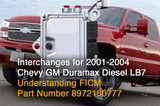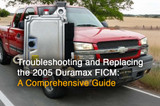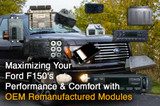Everything You Need to Know About the FICM for the 2004 Chevy 6.6L Duramax: LB7 vs. LLY Models
If you own a 2004 Chevy 6.6L Duramax diesel truck or are in the market for replacement parts, you’ve probably encountered questions about the Fuel Injection Control Module (FICM). The confusion typically arises because 2004 was a transitional year for this vehicle, with General Motors shifting from the LB7 engine to the LLY engine mid-year. These two engines require different FICMs, and understanding the differences is critical for ensuring compatibility and maintaining your truck’s performance.
This comprehensive guide will help you identify the correct FICM for your vehicle, understand the key differences between the LB7 and LLY engines, and avoid common pitfalls when replacing this essential component.
What Is a FICM and Why Does It Matter?
The Fuel Injection Control Module (FICM) is a vital part of the diesel fuel injection system. It controls the operation of the fuel injectors, ensuring precise timing and fuel delivery to the engine cylinders. Without a properly functioning FICM, your truck may experience:
- Hard starting or failure to start.
- Rough idling and misfires.
- Reduced fuel efficiency.
- Engine stalling or performance issues.
Given its importance, replacing the FICM with the correct type is essential, especially for a year like 2004, which saw two different engines in production.
The Mid-Year Engine Shift: LB7 vs. LLY
The 2004 Chevy 6.6L Duramax trucks were built with two different engines:
- Early 2004 Models: Featured the LB7 engine, introduced in 2001 and known for its strong performance but prone to injector failures.
- Mid-2004 to 2005 Models: Introduced the LLY engine, which addressed some of the LB7’s shortcomings, including better cooling and a revised fuel injection system.
- Each engine requires a different FICM, making it crucial to know which engine your truck has before purchasing a replacement.
How to Identify Your Engine Model
One of the simplest ways to determine your engine type is by checking the 8th digit of your Vehicle Identification Number (VIN):
- VIN ‘1’: Indicates the LB7 engine.
- VIN ‘2’: Indicates the LLY engine.
If you’re unsure how to locate your VIN, it’s typically visible through the windshield on the driver’s side dashboard or on the driver-side door frame.
Key Differences Between LB7 and LLY FICMs
Although both the LB7 and LLY FICMs serve the same purpose, they are not interchangeable due to design and functional differences:
- Connector Types: The connectors on the LB7 FICM differ from those on the LLY model.
- Fuel Flow Design: The LLY FICM was designed for “top-to-bottom” fuel flow, improving efficiency over the LB7 design.
- Electrical Compatibility: The electrical systems in the LB7 and LLY engines are configured differently, making the FICMs unique to each engine.
When to Replace Your FICM
If you notice any of the following symptoms, your FICM might need replacement:
When selecting a replacement FICM for your 2004 Duramax, consider the following:
- Verify Your Engine Type: Confirm whether your truck has the LB7 or LLY engine using the VIN.
- Purchase OEM or High-Quality Aftermarket Parts: Low-quality FICMs may fail prematurely or cause additional engine issues.
- Work with a Trusted Supplier: Choose a vendor that specializes in diesel parts and can provide guidance if you’re uncertain about compatibility.
FAQs About the 2004 Chevy Duramax FICM
Q: Can I use an LB7 FICM in an LLY engine or vice versa?
A: No, the FICMs are not interchangeable due to differences in connectors, fuel flow design, and electrical compatibility.
Q: How much does a replacement FICM cost?
A: Prices can range from $1440 to $1800, depending on whether you choose an OEM Remanufactured or aftermarket option.
Q: Can I install a new FICM myself?
A: While it’s possible for experienced DIY mechanics, professional installation is recommended to ensure proper functionality and avoid damage.
Using the NHTSA VIN Decoder to Identify Your Engine Type
The Vehicle Identification Number (VIN) is a 17-character code that provides essential information about your vehicle, including its manufacturer, model, engine type, and production year. One of the most reliable tools to decode this information is the NHTSA VIN Decoder, a free online resource provided by the National Highway Traffic Safety Administration.
Using the NHTSA VIN Decoder is straightforward. Simply locate your vehicle’s VIN—commonly found on the driver’s side dashboard, visible through the windshield, or inside the driver-side door frame. Then, visit the NHTSA VIN Decoder website and input the 17-digit code. The tool will generate a detailed report about your vehicle, including its engine type, production date, and other specifications.
For 2004 Chevy 6.6L Duramax owners, this tool can be particularly helpful in determining whether your truck has the LB7 or LLY engine. Look for the 8th digit of the VIN, which signifies the engine type:
- VIN ‘1’: Indicates the LB7 engine.
- VIN ‘2’: Indicates the LLY engine.
By using the NHTSA VIN Decoder, you can ensure that you’re selecting the correct Fuel Injection Control Module (FICM) and other parts for your truck. This eliminates guesswork, prevents costly mistakes, and helps maintain your vehicle’s performance and reliability.
For more information or to access the decoder, visit the NHTSA VIN Decoder website.
Conclusion
The 2004 Chevy 6.6L Duramax is unique due to its mid-year engine change, which requires careful attention when replacing components like the Fuel Injection Control Module. Understanding the differences between the LB7 and LLY engines, identifying your truck’s engine type, and selecting the correct FICM are essential for maintaining optimal performance.
When in doubt, consult a trusted automotive electronics expert or supplier to ensure you’re getting the right part for your truck. Proper care and attention can keep your Duramax running smoothly for years to come.
For more information on FICMs, diesel engine components, or assistance with part compatibility, feel free to contact our team at Auto & Truck Electronics!
Recent Posts
-
Understanding FICM Part Number 8972160777 and Interchanges for 2001-2004 Chevy GM Duramax Diesel LB7
If you're looking to replace the Fuel Injection Control Module (FICM) in your 2001-2004 Chevy GM Dur …Apr 29, 2025 -
Troubleshooting and Replacing the 2005 Duramax FICM: A Comprehensive Guide
The Fuel Injection Control Module (FICM) is a critical component of your 2005 Duramax engine, respon …Apr 29, 2025 -
Maximizing Your Ford F150's Performance and Comfort with OEM Remanufactured Modules
As a Ford F-150 owner, you know how important it is to keep your vehicle running smoothly and effici …Apr 29, 2025




